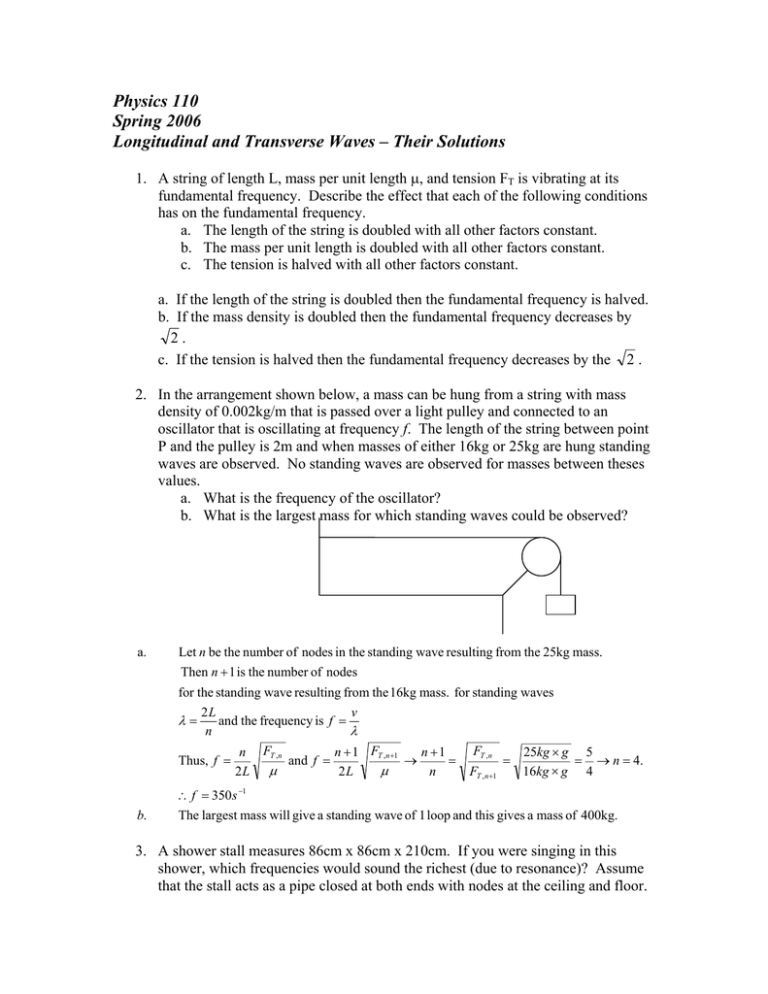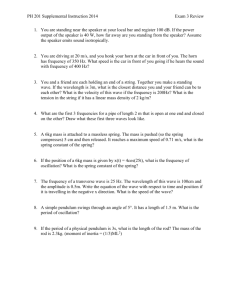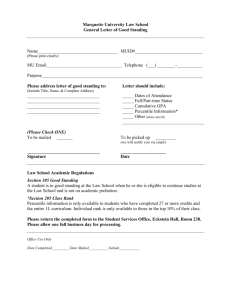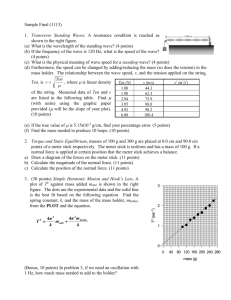Physics 110 Spring 2006 Longitudinal and Transverse Waves – Their Solutions
advertisement

Physics 110 Spring 2006 Longitudinal and Transverse Waves – Their Solutions 1. A string of length L, mass per unit length µ, and tension FT is vibrating at its fundamental frequency. Describe the effect that each of the following conditions has on the fundamental frequency. a. The length of the string is doubled with all other factors constant. b. The mass per unit length is doubled with all other factors constant. c. The tension is halved with all other factors constant. a. If the length of the string is doubled then the fundamental frequency is halved. b. If the mass density is doubled then the fundamental frequency decreases by 2. c. If the tension is halved then the fundamental frequency decreases by the 2 . 2. In the arrangement shown below, a mass can be hung from a string with mass density of 0.002kg/m that is passed over a light pulley and connected to an oscillator that is oscillating at frequency f. The length of the string between point P and the pulley is 2m and when masses of either 16kg or 25kg are hung standing waves are observed. No standing waves are observed for masses between theses values. a. What is the frequency of the oscillator? b. What is the largest mass for which standing waves could be observed? a. Let n be the number of nodes in the standing wave resulting from the 25kg mass. Then n + 1 is the number of nodes for the standing wave resulting from the 16kg mass. for standing waves 2L v λ= and the frequency is f = λ n FT ,n n FT ,n n + 1 FT ,n +1 n +1 25kg × g 5 → = = = → n = 4. Thus, f = and f = µ 2L µ 2L n FT ,n +1 16kg × g 4 ∴ f = 350 s −1 b. The largest mass will give a standing wave of 1 loop and this gives a mass of 400kg. 3. A shower stall measures 86cm x 86cm x 210cm. If you were singing in this shower, which frequencies would sound the richest (due to resonance)? Assume that the stall acts as a pipe closed at both ends with nodes at the ceiling and floor. Also assume that the voices of anyone using the shower range in frequency from 130s-1 to 2000s-1 and that the speed of sound in the shower stall is 355m/s. fn = ( ( ) ) nv → n 206s −1 = f n 2L → n 84.5s −1 = f 'n for L = 0.86m and n = 1 to 9 for L = 2.10m and n = 2 to 23 4. Suppose that you hear a clap of thunder 16.2 s after seeing the lightning stroke. If the speed of sound in the air is 343 m/s and the speed of light in air is 3x108 m/s, how far are you from the lightning strike? vsound = d → d = vsound t = 343 ms × 16.2 s = 5560m = 3.5mi t 5. A bat can detect very small objects, such as an insect whose length is approximately equal to one wavelength of the sound the bat makes. If bats emit chirps at a frequency of 60s-1, and if the speed of sound in air is 340m/s, what is the smallest insect a bat can detect? v = fλ → λ = 340 ms v = = 5.67 × 10 −3 m = 5.67 mm f 60 × 103 s −1 6. What is the sound level, in decibels, of a sound wave that has an intensity of 4.0µW/m2? ⎛ 4 ×10 −6 mW2 ⎛I ⎞ ⎜ ⎟ β = 10 log⎜ ⎟ = 10 log⎜ ⎜ 1×10 −12 W2 ⎝ I0 ⎠ m ⎝ ⎞ ⎟ = 66.0dB ⎟ ⎠ 7. The ocean floor is underlain by a layer of basalt that constitutes the crust, or upper most layer, of the Earth in that region. Below the crust is found denser peridotite rock, which forms the Earth’s mantle. The boundary between these two layers is called the Mohorovicic discontinuity. If an explosive charge is set off at the surface of the basalt, it generates a seismic wave that is reflected back out at the Mohorovicic discontinuity. If the speed of the wave in the basalt is 6.5km/s and the two -way travel time is 1.85s, what is the thickness of the oceanic crust? v= total distance 2d vt = →d = = time t 2 1 2 (6.50 ×10 3 m s ) ×1.85s = 6010m = 6.01km








